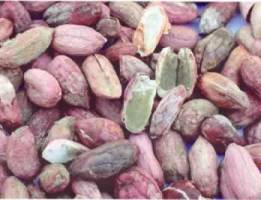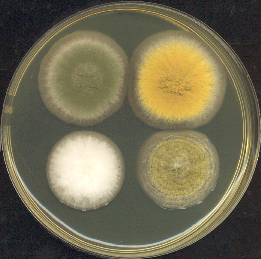Interactions
As I mentioned in the habitat section, A. flavus has the capacity to grow on many nutrient sources. This may include tissues that are dead or alive. A. flavus can be pathogenic to several plant and animal species, including humans! The fungus can infect seeds of corn, peanuts, cotton, and nut trees. The infections can occur while the crops are still in the field, but often show no symptoms until post-harvest storage or transport. Below you can see peanuts infected by A. flavus.
 Growth of this fungus on a food source often leads to
contamination with aflatoxin, a toxic and carcinogenic compound. A.
flavus produces various mycotoxins including aflatoxin B1 which is
considered severely toxic, extremely cancer-causing, and also liver
damaging. Aspergillus flavus can be relatively low risk causing
mycosis in healthy individuals or pose as a moderate risk for
individuals with a compromised immune system such as an individual
with
HIV.
Luckily, there are medicines available for the treatment of mycotoxicosis.
Growth of this fungus on a food source often leads to
contamination with aflatoxin, a toxic and carcinogenic compound. A.
flavus produces various mycotoxins including aflatoxin B1 which is
considered severely toxic, extremely cancer-causing, and also liver
damaging. Aspergillus flavus can be relatively low risk causing
mycosis in healthy individuals or pose as a moderate risk for
individuals with a compromised immune system such as an individual
with
HIV.
Luckily, there are medicines available for the treatment of mycotoxicosis.
Aspergillus flavus is also the second leading cause of aspergillosis in humans, the first being Aspergillus fumigatus. Aspergillosis can occur in various organs of humans and animals. Under normal circumstances, when Aspergillus spores are inhaled our immune systems can recognize them and destroy them. However, people with weakened immune systems are more susceptible, also those with previous health problems such as tuberculosis. The most common invasive aspergillosis is in the lungs called pulmonary aspergillosis. Less common are aspergillosis of other tissues such as the central nervous system, sinuses, bone, heart, kidney, eye, blood and skin.
 Other Aspergillus species that pose a potential
harm to humans include
Other Aspergillus species that pose a potential
harm to humans include
- A. clavatus
- A. fumigatus
- A. glaucus
- A. nidulans
- A. niger
- A. oryzae
- A. terreus
- A. ustus
- A. versicolor
To find out more about aflatoxin go to the mycotoxin page!



